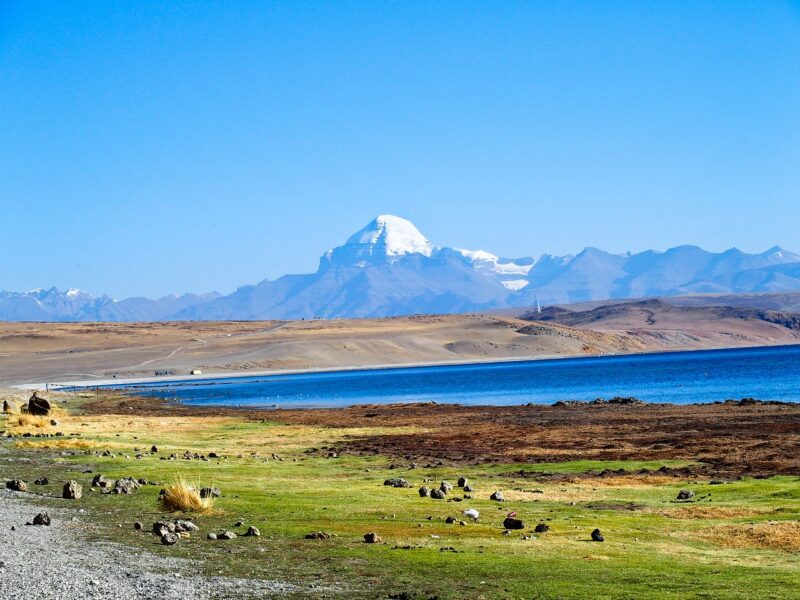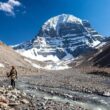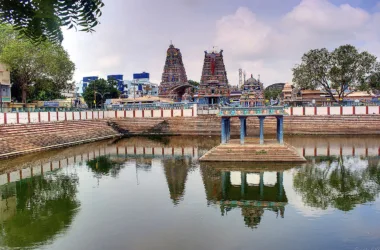Kailash Mansarovar, a sacred and awe-inspiring destination, is nestled in the remote regions of the Tibetan Plateau. This article invites you to explore the magnificent beauty of Kailash Mansarovar, an extraordinary place that holds immense spiritual significance for millions of people around the world. Let’s embark on this virtual journey to discover the wonders that await at the roof of the world.
Table of Content
- What is Kailash Mansarovar?
- Spiritual Significance
- Geographical Location
- Pilgrimage Route
- Cultural Significance
- Mount Kailash
- Lake Mansarovar
- Trekking and Yatra
- Best Time to Visit
- How to Reach
- Accommodation Options
- Safety Tips
- Conclusion
- FAQs
What is Kailash Mansarovar?
Kailash Mansarovar is a revered pilgrimage site located in the southwestern part of Tibet, China. It is renowned for its stunning natural beauty, religious importance, and mythical associations. The region encompasses two main attractions: Mount Kailash, a majestic peak, and Lake Mansarovar, a pristine freshwater lake.
Spiritual Significance
Kailash Mansarovar holds immense spiritual significance in Hinduism, Buddhism, Jainism, and Bon. For Hindus, it is believed to be the abode of Lord Shiva, the destroyer and transformer in the Hindu trinity. Buddhists consider the region sacred as it is associated with the life and enlightenment of Lord Buddha. The serene atmosphere and breathtaking landscapes make it an ideal place for meditation and spiritual retreat.
Geographical Location
Situated in the western part of the Tibetan Autonomous Region, Kailash Mansarovar is nestled amidst the breathtaking Himalayan mountain range. The region is known for its rugged terrain, snow-capped peaks, and vast open spaces. Its remote location adds to the mystique and allure of this sacred pilgrimage site.
Pilgrimage Route
The journey to Kailash Mansarovar is a profound and arduous pilgrimage that tests the devotion and endurance of pilgrims. The most common route begins from Kathmandu, Nepal, and passes through scenic landscapes, remote villages, and high-altitude mountain passes. The circumambulation (kora) of Mount Kailash and the ritualistic bath in Lake Mansarovar are significant aspects of the pilgrimage.
Cultural Significance
Kailash Mansarovar is not only a religious destination but also a cultural treasure trove. The local Tibetan culture, influenced by Buddhism, offers a unique experience for visitors. The vibrant monasteries, colorful prayer flags, traditional rituals, and warm hospitality of the local people add to the rich tapestry of the pilgrimage experience.
Mount Kailash
Mount Kailash, also known as Kang Rinpoche, is the centerpiece of the Kailash Mansarovar pilgrimage. This pyramid-shaped peak stands tall at an elevation of 6,638 meters (21,778 feet) and is considered one of the most sacred mountains in the world. Its majestic presence, adorned with snow and ice, is a sight to behold and inspires awe and reverence among pilgrims and adventurers alike.
Lake Mansarovar
Lake Mansarovar, located at the foot of Mount Kailash, is a shimmering jewel in the Tibetan plateau. It is known for its crystal-clear turquoise waters and tranquil surroundings. The lake is believed to possess healing properties and is regarded as a source of spiritual rejuvenation. Pilgrims often take a dip in its holy waters as part of their religious rituals.
Trekking and Yatra
Embarking on a trek or yatra (pilgrimage) to Kailash Mansarovar is a transformative experience. The journey takes you through a diverse landscape of alpine meadows, rocky terrains, and high-altitude passes. The challenging yet rewarding trek offers breathtaking vistas and an opportunity to witness the raw beauty of nature up close.
Best Time to Visit
The best time to visit Kailash Mansarovar is during the summer months, from May to September. The weather is relatively mild, and the mountain passes are accessible during this period. However, it is important to note that the region experiences sudden weather changes, and it is advisable to be prepared for unpredictable conditions.
How to Reach
Reaching Kailash Mansarovar requires meticulous planning and coordination. The journey typically begins with a flight to Kathmandu, Nepal, followed by an overland drive to the border town of Hilsa. From there, a combination of road travel and trekking is undertaken to reach the sacred destination. Various travel agencies and tour operators specialize in organizing Kailash Mansarovar yatras, ensuring a smooth and hassle-free experience for pilgrims.
Accommodation Options
While embarking on the Kailash Mansarovar pilgrimage, accommodations range from basic guesthouses to tents and campsites. Along the route, there are limited options for lodging, with most facilities offering simple amenities. It is advisable to carry essential supplies and be prepared for rustic living conditions during the journey.
Safety Tips
Traveling to Kailash Mansarovar requires careful preparation and attention to safety. Here are a few tips to ensure a safe and enjoyable pilgrimage:
- Acclimatize properly to the high altitude to avoid altitude sickness.
- Pack warm clothing, as the weather can be unpredictable.
- Stay hydrated and carry enough drinking water.
- Follow the guidance of your tour guide and local authorities.
- Respect the local customs, traditions, and religious sentiments.
Conclusion
Kailash Mansarovar, with its majestic beauty and spiritual significance, is a destination that captivates the hearts and minds of travelers and pilgrims. It offers an opportunity to connect with nature, seek spiritual enlightenment, and witness the convergence of cultures. Embark on this transformative journey to Kailash Mansarovar and experience the profound wonders that await at the roof of the world.
Similar Articles
- Srikalahasti Temple: History & Architecture
- Murdeshwar: World’s 2nd Tallest Shiva Statue
- Rameshwaram Temple
FAQs
Is Kailash Mansarovar open for tourists throughout the year?
Kailash Mansarovar is open for tourists and pilgrims from May to September, which is considered the best time to visit. The region experiences harsh weather conditions during the winter months, making it inaccessible for most travelers.
Are there any age restrictions for the Kailash Mansarovar pilgrimage?
While there are no specific age restrictions, the pilgrimage to Kailash Mansarovar involves physically demanding treks and high altitudes. It is advisable for participants to be in good health and consult their healthcare provider before undertaking the journey.
Can I visit Kailash Mansarovar independently, or do I need to join a guided tour?
To visit Kailash Mansarovar, it is highly recommended to join a guided tour or yatra organized by experienced travel agencies. They provide essential logistical support, including permits, transportation, accommodation, and knowledgeable guides who ensure a safe and enriching pilgrimage experience.
Is photography allowed in Kailash Mansarovar?
Yes, photography is generally allowed in Kailash Mansarovar. However, it is advisable to respect the local customs and seek permission before photographing religious ceremonies or individuals.
Can I combine the Kailash Mansarovar pilgrimage with other nearby attractions?
Yes, many travelers choose to combine their visit to Kailash Mansarovar with nearby attractions such as Mount Everest Base Camp, Lhasa, or other parts of Tibet. It allows for a more comprehensive exploration of the region’s cultural and natural wonders.
Are there any restrictions or special requirements for obtaining permits to visit Kailash Mansarovar?
Yes, obtaining permits to visit Kailash Mansarovar involves certain requirements and procedures. Foreign visitors need to obtain the necessary permits and visas from the Chinese government, while Indian pilgrims must go through the Ministry of External Affairs of the Government of India. It is advisable to consult with a travel agency or tour operator to understand the specific permit requirements and assistance in obtaining them.
What are the accommodation options during the Kailash Mansarovar pilgrimage?
Along the pilgrimage route, there are limited accommodation options ranging from guesthouses to basic lodges and campsites. These facilities provide simple amenities such as beds, blankets, and meals. It is important to note that the accommodation during the pilgrimage is basic and not luxurious, as the focus is on the spiritual journey and connecting with nature.
How physically demanding is the Kailash Mansarovar trek?
The Kailash Mansarovar trek can be physically demanding due to the high altitude and challenging terrain. The trek involves walking long distances, ascending steep slopes, and crossing mountain passes. It requires a good level of physical fitness, endurance, and prior acclimatization to the high altitude. It is advisable to engage in regular exercise and prepare yourself physically before undertaking the pilgrimage.
Can I travel to Kailash Mansarovar with the children?
While it is possible to travel to Kailash Mansarovar with children, it is important to consider the physical demands and high altitude of the pilgrimage. Children must be in good health and capable of enduring long hours of travel and trekking. It is advisable to consult with a healthcare professional and seek their guidance before planning a trip with children.
Is it possible to hire porters or mules to carry luggage during the Kailash Mansarovar trek?
Yes, it is possible to hire porters or mules to carry luggage during the Kailash Mansarovar trek. This can help lighten the load and make the journey more manageable, especially for those who may have difficulty carrying heavy backpacks. It is recommended to discuss this option with your travel agency or tour operator in advance.
What should I pack for the Kailash Mansarovar pilgrimage?
Packing for the Kailash Mansarovar pilgrimage requires careful consideration. It is essential to pack warm clothing, including thermals, jackets, gloves, and hats, as the weather can be cold and unpredictable. Other items to consider include comfortable trekking shoes, sunscreen, sunglasses, a first aid kit, a water bottle, and personal toiletries. It is advisable to pack light and carry only the essentials, as you will be trekking for several days.









